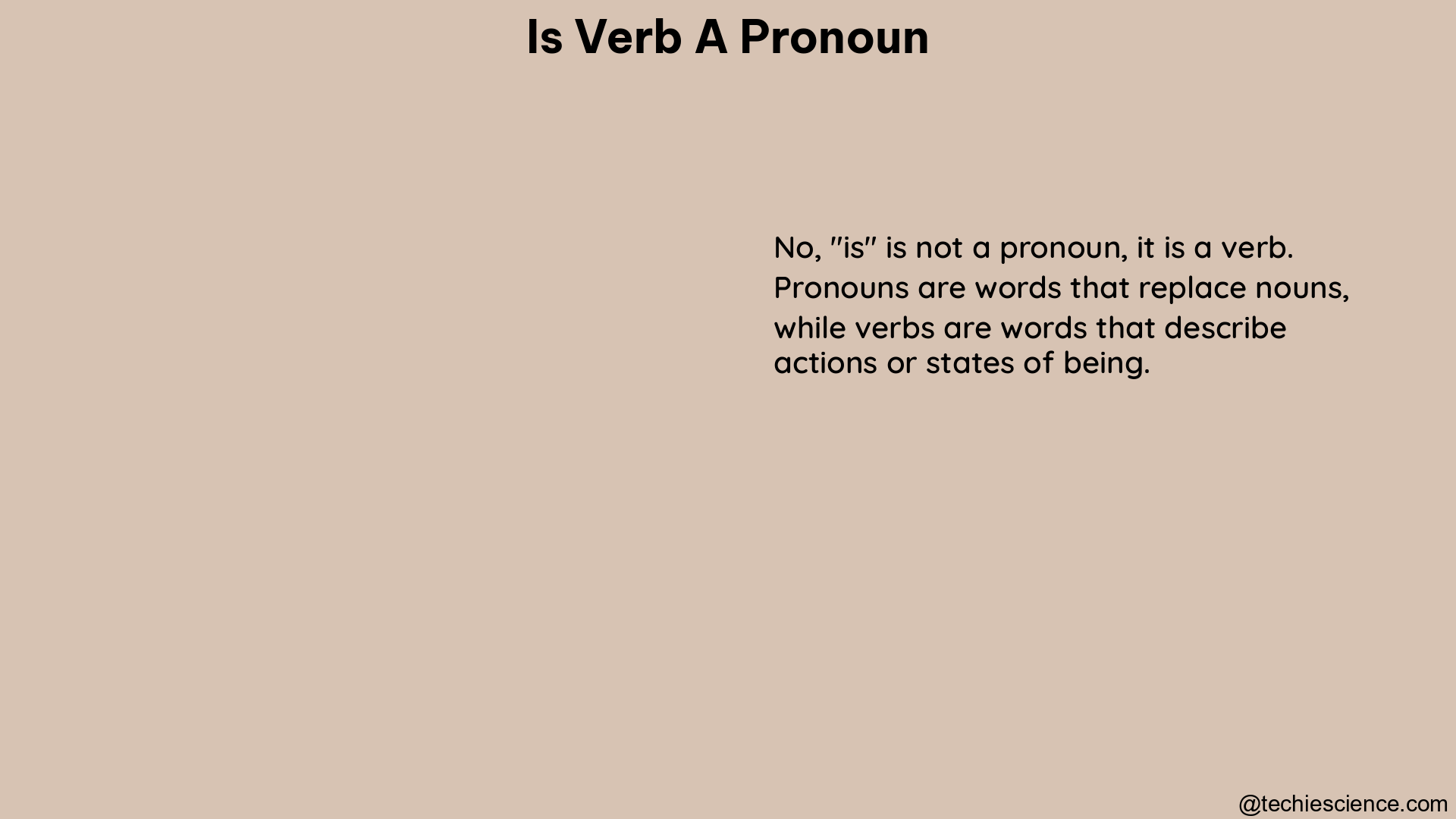No, a verb is not a pronoun. Verbs and pronouns are two distinct parts of speech in the English language, each with their own functions and characteristics. In this comprehensive guide, we will delve into the definitions, functions, and key differences between verbs and pronouns, providing you with a thorough understanding of these essential grammatical concepts.
Definition and Function of Verbs
Verbs are words that express actions, occurrences, or states of being. They describe what is happening in a sentence and can be classified into different types, such as:
- Action Verbs: These verbs describe physical or mental actions, such as “run,” “jump,” “think,” and “write.”
- Linking Verbs: These verbs connect the subject to additional information, such as “be,” “become,” and “seem.”
- Helping Verbs: Also known as auxiliary verbs, these are used in combination with main verbs to form verb phrases, such as “will run,” “has written,” and “can jump.”
Verbs are the essential components of a sentence, as they convey the action or state of being that is taking place. They are crucial for effective communication and grammatically correct writing.
Definition and Function of Pronouns

Pronouns, on the other hand, are words that replace nouns or noun phrases in a sentence. They can be used to refer to specific people, places, things, or ideas without repeating the noun. Pronouns can be classified into different types, such as:
- Personal Pronouns: These pronouns refer to specific individuals or things, such as “I,” “you,” “he,” “she,” “it,” “we,” and “they.”
- Possessive Pronouns: These pronouns indicate ownership or possession, such as “mine,” “yours,” “his,” “hers,” “its,” “ours,” and “theirs.”
- Reflexive Pronouns: These pronouns refer back to the subject of the sentence, such as “myself,” “yourself,” “himself,” “herself,” “itself,” “ourselves,” and “themselves.”
- Relative Pronouns: These pronouns introduce a relative clause and connect it to the main clause, such as “who,” “whom,” “whose,” “which,” and “that.”
- Demonstrative Pronouns: These pronouns point to specific people, places, or things, such as “this,” “that,” “these,” and “those.”
Pronouns are essential for avoiding repetition and maintaining coherence in written and spoken language. They allow us to refer to nouns without constantly repeating them, making our communication more concise and efficient.
Key Differences between Verbs and Pronouns
- Function: Verbs describe actions or states, while pronouns replace nouns or noun phrases.
- Examples: Verbs include “run,” “jump,” “think,” and “be,” while pronouns include “I,” “you,” “he,” “she,” “it,” “we,” and “they.”
- Usage: Verbs are used to form verb phrases and describe actions, while pronouns are used to refer to nouns without repetition.
Examples
- Verb Example: “She is running.” (Here, “is running” is the verb phrase describing the action.)
- Pronoun Example: “He gave the book to her.” (Here, “he” and “her” are pronouns replacing nouns.)
Identifying Verbs and Pronouns
To identify verbs and pronouns in a sentence, look for the following:
- Verbs: Words that express actions, occurrences, or states of being. They can be classified as action verbs, linking verbs, or helping verbs.
- Pronouns: Words that replace nouns or noun phrases, such as personal pronouns, possessive pronouns, reflexive pronouns, relative pronouns, and demonstrative pronouns.
By understanding the definitions, functions, and key differences between verbs and pronouns, you can confidently identify and use these essential parts of speech in your written and spoken communication.
Advanced Concepts
- Verb Tenses: Verbs can be conjugated to express different time frames, such as present, past, and future tenses.
- Verb Moods: Verbs can also be used to express different moods, such as indicative, imperative, subjunctive, and conditional.
- Pronoun Case: Pronouns can be in different cases, such as subjective (I, he, she), objective (me, him, her), and possessive (my, his, her).
- Pronoun Agreement: Pronouns must agree with the noun they are replacing in terms of number (singular or plural) and gender (masculine, feminine, or neuter).
Understanding these advanced concepts will further enhance your mastery of verbs and pronouns, allowing you to communicate more effectively and accurately.
Conclusion
In conclusion, verbs and pronouns are distinct parts of speech with different functions and characteristics. Verbs describe actions or states, while pronouns replace nouns or noun phrases. Recognizing the differences between these two essential grammatical elements is crucial for effective communication and grammatically correct writing.
Reference:
- https://www.seaford.k12.ny.us/cms/lib011/NY01000674/Centricity/Domain/335/PARTS%20OF%20SPEECH%2015.pdf
- https://www.dictionary.com/e/parts-of-speech/
- https://www.britannica.com/dictionary/eb/qa/parts-of-speech-noun-pronoun-verb

Hi! I am Bhabesh Sing. I have completed M.A in English, M.A in Vocal Music, and B.Ed. I am a creative writer. Currently, I am a Subject Matter Expert in English on this Platform.
Let’s connect through LinkedIn-https://www.linkedin.com/in/bhabesh-sing-660914ab